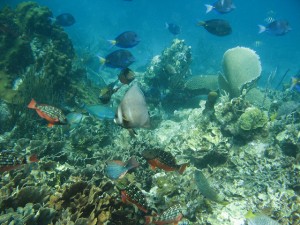A natural underwater Atlantis is found beneath the crystal clear waters of the Caribbean; clustered corals of all shapes and colours create the home of a vibrant array of fish species. But these reef ecosystems are declining and are threatened with destruction unless the corals can be saved. Marine researchers have uncovered the secret to breeding pillar corals in the laboratory with the hope that these can be transplanted to reefs to reverse such trends.
Corals are soft-bodied organisms which associate with algae, they form a hard limestone base which forms the structure of reefs. These cover less than a quarter of one percent of the ocean floor yet support 25% of all marine life. That equates to 2 million species whilst also acting as a nursery to a quarter of the oceans fish. In addition to the beauty of an ecosystem rivalling the diversity of the Amazon rainforest, coral reefs are vital fisheries. If sustainably managed, one square kilometre can yield 15 tonnes of fish per year whilst the total commercial annual output of coral fisheries is valued at $5.7 billion. Furthermore, coral reef fish species are a significant food resource for over a billion people worldwide and are the principle protein source for 85% of this total. Therefore, it is of paramount importance that we conserve these ecosystems.
However, one quarter of coral reefs are considered damaged beyond repair whilst the remainder are under serious threat. The warming ocean temperature has disrupted their associations with algae; this is known as bleaching and leads to the death of corals. Climate change has increased CO2 levels; this has raised the acidity of the ocean which then dissolves the coral limestone skeleton. Moreover, pollution from oil, industry and agriculture has poisoned the corals thus furthering their decline. Overfishing also poses a threat through disordering the complex food webs of the ecosystem whilst fishing practices such as trawling can directly damage the reef.
Pillar corals of the Caribbean reef (copyright – BioMed Central)
Marine researcher Kristen Marhaver and her team are hoping to reverse these effects through raising juvenile pillar corals in the laboratory environment. Coaxing the corals into reproduction was a difficult task; Dr. Marhaver drew the “analogy to in vitro fertilization in humans.” Pillar corals build single gender colonies and spawn eggs or sperm on very few nights annually. The offspring then grow at just half an inch per year. However, the team succeeded and learnt of the optimal conditions of water, bacteria and other species that help them to grow in the wild. Furthermore, there is hope that these laboratory grown juveniles could be transplanted back to the Caribbean reefs to regenerate the ecosystems. Marhaver added, “We do see that coral juveniles can survive in places where the adults are suffering badly, so we are thinking that some reefs can recover in places we have given up on.” Such research can only help to protect and potentially regenerate these crucial coral reef ecosystems upon which so much is dependent.
Toby Buttress








